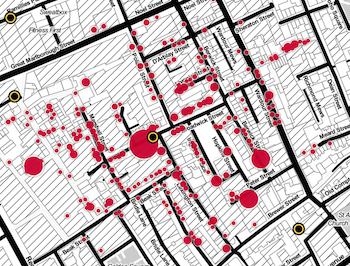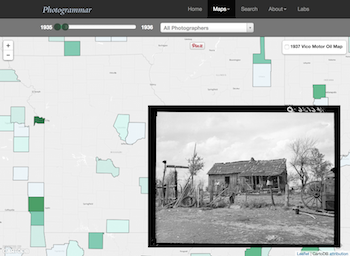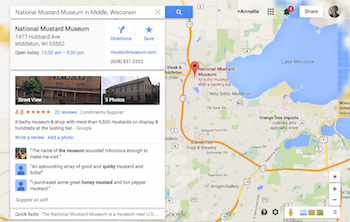Maps of Real Places from Alaska to Afghanistan:
Connecting Reading and Technology
To truly understand the history of conflict in the Middle East or the need for conservation efforts in Africa, youth need a combination of experiences. Characters in books for youth like The Breadwinner by Deborah Ellis and Endangered by Eliot Schrefer bring global issues to the forefront, while the maps in these books help youth better understand the context of these conflicts and dilemmas. Maps are visual guides to the world. These graphic representations assist children and young adults better understand historical, political, cultural, scientific, and other aspects of their world. Through maps, youth can discover evidence, build effective arguments, and make informed decisions.
Unfortunately, the paper map found in a traditional book is limited in its ability to convey the beauty of a landscape or the hazards of a war zone. Technology tools can enhance the experience by providing satellite images to picture a location, interactive maps to dynamically represent data, or tools to visualize the complexity of our world.
Current Maps
Many fictional works for youth contain maps that represent the current status of real places around the world. Stories often reflect both the physical and cultural landscape of the place where they are set.
A Girl Named Disaster by Nancy Farmer traces Nhamo’s Journey from Mozambique to Zimbabwe to escape an unwanted marriage. The book’s maps provide an overview of the continent along with the two countries. Google Earth would be useful in providing an overview of the area, along with the ability to zoom in on details such as the rivers and lakes.
Also set in Africa, Endangered and Threatened by Eliot Schrefer are the first two books in a series focusing on the bonobo population. The map in Endangered shows The Democratic Republic of Congo formerly known as Zaire. An interactive map from the Bonobo Conservation Initiative identifies the locations of bonobo protected areas.
Based on interviews with women and children living under Taliban rule, The Breadwinner Trilogy by Deborah Ellis focuses on life in Afghanistan. The book includes one map showing Afghanistan’s location in the world and a second map identifying the major cities of Afghanistan and nearby countries. These line drawings are useful in showing the relative location of the country, but they don’t give readers a feel for the terrain. Google Earth is a great tool to help youth visualize this location. They can see an overview of the bombed out buildings and dry environment.
Many of Will Hobbs’s books contain maps. Never Say Die by Will Hobbs shows a map of Alaska along with the Yukon and Northwest Territories. Use topographical maps to bring the terrain of the area surrounding the Firth River to life. Download Topographical Maps of the region. Also, use an interactive map to learn about the types of scientific projects happening in Northern Canada. The USGS provides free topographical maps that can be downloaded in the PDF format.
Like Will Hobbs, Gary Paulsen is also known for his books about Alaska. Woodsong by Gary Paulsen contains a map of Alaska focusing on the Iditarod sled dog race. The Official Race map is a great way to help youth explore concepts related to distance through the sled dog race.
Each book in the National Park mystery series by Gloria Skurzynski and Alane Ferguson focuses on a different national park. Excellent maps show the location of the park in the United States along with a detailed map of the park. The National Park Service is known for their quality maps for each national park. The Adventures with the Parkers series by Mike Graf incorporate the official National Park Service maps into their books. Use the Find A Park interactive map to locate parks by name, location, activity, and topic.
In The Maze by Will Hobbs, a map shows the Maze District of Canyonlands National Park. The map provides a nice overview of key locations associated with the book. However, a visit to the Canyonlands National Park website provides more in-depth maps, distance information, and useful facts about Canyonlands.
Wild Man Island by Will Hobbs takes place on Alaska’s A-B-C islands of Admiralty-Baranof-Chichagof. The book provides a map with the key locations. Google Images is a quick way to locate additional maps that have useful information about the vegetation, topography, and other details. Do a Google search for Admiralty-Baranof-Chichagof map.
In Crossing the Wire by Will Hobbs, a young boy crosses between Mexico and Arizona. A map shows the borderlands as well as a larger view of the area. Many online news sources provide current maps of the borderlands and issues associated with border crossings.
Historical Maps
When reading historical fiction, it can be helpful for students to use historical maps. This is particularly important with historical fiction where locations may have changed tremendously over time. For instance, the USGS Historical Topographic Maps allows users to overlay maps from the past with maps from the present for locations throughout the United States.
Ghost Hawk by Susan Copper is set in 17th century New England. Involve youth in learning to use digital collections to find maps of particular time periods such as those from OsherMaps.
Many maps serve scientific purposes. One of the most famous maps was produced by Dr. John Snow during London’s cholera epidemic. The Great Trouble: A Mystery of London, the Blue Death, and a Boy Called Eel is a work of historical fiction by Deborah Hopkinson. Focusing on London’s cholera epidemic, a map created by Dr. John Snow plays a critical role in identifying the cause of the epidemic. Use this book and map to jumpstart a discussion of the role maps can play in a wide range of scientific investigations. An interactive version of this map is available at The Guardian.
Rebels of the Kasbah by Joe OíNeill contains a map of the world as well as an up-close view of Morocco.
Some works of historical fiction incorporate world maps. Stowaway by Karen Hesse includes a world map published around 1800. Get youth involved in exploring historical maps of the world. For lots of examples, go to the David Rumsey Map Collection.
Inspired by family stories, The Birchbark House by Louis Erdrich includes a hand drawn map containing an overview of the local community in 1847 along with a map of present day northern Minnesota. Use the Ojibwe People’s Dictionary <http://ojibwe.lib.umn.edu> to associate historical photos such as the dwellings with the icons used on the map. Also, look at how Indian lands changed after this story took place at The Invasion of America.
Indian Captive: The Story of Mary Jemison by Lois Lenski contains a picture map of the Seneca Indian lands of the Genesee River Valley between 1758-1760. Ask students to compare a Historical Map to the drawing in the book. Also, use maps to show the location of Indian groups throughout the United States.
Rather than exploring the entire world, the map in Jason’s Gold by Will Hobbs focuses on the Pacific Northwest in 1897 associated with the Klondike gold rush. The map provides an overview, but lacks a feel for the historical aspects. The National Park Service maps can fill the gap between the general map in the book and the specific areas mentioned in the book including Seattle, Skagway, and the routes north. Discovery Channel <http://www.discovery.com/tv-shows/klondike/maps> provides interactive maps of the area with historical photos. The David Rumsey Map Collection contains a great map published in 1898 showing routes north.
In many cases, historical fiction is set in a particular town or city. Brooklyn Bridge by Karen Hesse includes a detailed map of 1903 Brooklyn on the endpapers. You can find many online maps of the Brooklyn Bridge area Unfortunately, we don't have a historical version of Google Street View. However you can create your own by locating images referred to on the map. The Library of Congress is a great place to start. A search for Brooklyn Bridge yields an image from between 1900 and 1910, a perfect match for the book.
The Bomb by Theodore Taylor contains a map of the Bikini Atoll in the Western Pacific Ocean. However, an even more interesting map of the BRAVO Test Fallout Pattern helps reader understand the impact of the bomb on islanders.
The map in A Tale from Alcatraz series by Gennifer Choldenko is a labeled photograph of the island of Alcatraz. The National Park Service provides both current and historical maps of Alcatraz.
While many fiction books for children and young adults contain maps, others focus on specific locations but don’t include maps or other visuals to help youth envision the setting. For instance, Moon Over Manifest by Clare Vanderpool is set in Missouri during the Depression. HistoryPin is another project that matches locations with historical images.
Rodzina by Karen Cushman follows a twelve-year-old girl as she travels west on the orphan train in 1881. Use old railroad maps to trace her path across the United States as she travels through Illinois, Iowa, Nebraska, Wyoming, Utah, and Nevada to California chapter by chapter. The Library of Congress Railroad Maps, 1828-1900 collection contains dozens of maps for youth to explore. Discuss what map would be best for identifying the railroad lines in 1881. Help youth use the search tools. Ask them to select and defend their choice of a map that would be most useful in tracking Rodzina’s way west such as the 1875 Rand McNally & Co’s New Railroad and County Map.
Historical Trail Maps. From the Silk Road to the Oregon Trail, books for youth sometimes revolve around a trail of historical significance.
Sacajawea by Joseph Bruchac includes a map of the Lewis and Clark Trail. Check out an interactive map of the Lewis and Clark Trail.
Set along the Oregon Trail, the Petticoat Party series by Kathleen Karr incorporates a map of the Oregon Trail. The Oregon Trail website provides an easy-to-use interactive map including the key locations along the Oregon Trail. The Mr. Tucket series by Gary Paulsen also contains a map that includes the Oregon Trail.
A number of books are set during the Han Dynasty in China. Dragon Keeper by Carole Wilkinson is a work of fantasy, but incorporates real places in China. Each book in the Three Kingdoms series by Wei Dong Chen and Xiao Long Liang begins with a map showing the key locations in this graphic historical novel.
Historical Conflict Maps. From battle maps to escape routes, maps are often associated to works of historical fiction set during time of conflict.
Once on this Island by Gloria Whelan focuses on northern Michigan and specifically Mackinac Island during the War of 1812. The map in the book shows the area in 1812.
The map in Soldier’s Heart by Gary Paulsen focuses on the service of a young adult in the First Minnesota Volunteers. Many online, interactive maps including Civil War Animated can be used to help youth understand Civil War battles.
Between Shades of Gray by Ruta Sepetys is set in 1941. Maps shows the route Lina and her family traveled from Lithuania to the North Pole during the course of the book. An accompanying timeline shows the day of the journey and their location. The United States Holocaust Memorial Museum (USHMM) provides a wealth of information and historical maps showing Lithuania and other locations from the time period. Rose Under Fire by Elizabeth Wein takes place at the Ravensbruck Concentration Camp. Readers can view maps of the camp at the USHMM .
For lots of other examples of how historical maps can be used in the classroom, go to Historic Maps in K-12and Library of Congress Map Collections.
Informational Books and Maps
Many of today’s most popular informational books convey content through a compelling scientific, cultural, or historical narrative.
Chasing Lincoln’s Killer by James L. Swanson incorporates a map of the assassinís route. An interactive map shows the key locations. Ask students to use Google Maps to trace the same route today. Identify the place names that have changed and those that have remained the same.
Passenger on the Pearl by Winifred Conkling tells the true story of Emily Edmonson’s flight from slavery. The nonfiction book includes maps showing the escape route of those slaves leaving on the Pearl and the routes of slaves sold to the South during what is known as the Second Middle Passage. Pair this work of nonfiction with fictional accounts of slave escape attempts. Online maps can be used to highlight specific aspects of slavery and the Underground Railroad.
The US Slave Animation map shows slave and free states between 1789 and 1861. Extend the discussion with an exploration of other Underground Railroad escape attempts. The National Park Service Underground Railroad Map provides a map showing hundreds of locations related to the Underground Railroad.
Unbroken by Laura Hillenbrand is a young adult adaptation of the bestselling book about Olympic runner Louie Zamperiniís experience as a castaway and captive during World War II. A map of the Pacific Ocean provides an overview of the setting for this engaging, true story. Involve youth in making their own map to trace his experiences.
Plastic Ahoy! Investigating the Great Pacific Garbage Patch by Patricia Newman tells the story of scientists investigating the huge cluster of plastic debris in the Pacific Ocean. A map of the region in the book shows the ocean currents and debris. NOAA Marine Debrisshows a similar view of these patterns. Do a Google Images search to locate dozens of infographics containing maps such as the one at Visual.ly. Ask students to pick the visual that they think best represents the problem and explain why.
The Case of the Vanishing Little Brown Bats: A Scientific Mystery (2015) by Sandra Markle includes a map of the eastern half of the United States showing the areas with bats affected by White-Nose Syndrome. Involve youth in seeking out maps and information from specific states. Ask students to compare the data from the book’s map with what they find. Also, involve then in tracing the changes over time. The White-Nose Syndrome website posts updated maps every few months.
The Polar Bear Scientists by Peter Lourie from the Smithsonian Scientists in the Field series follows biologists as they track polar bears to learn more about global warming. The Bear Tracker website contains an interactive map where youth can follow bears in close to real-time.
Increasingly, books for youth are incorporating maps and satellite images. The Skull in the Rock by Lee R. Berger and Marc Aronson incorporates maps and labeled images from Google Earth.
Books, Maps, and the School Library
Maps have always been an important part of a school’s library. Work with teachers to connect maps found in fiction and nonfiction books to Standards for the 21st Century Learner and content area standards. Extend the experience with online resources and tools. Using online tools, students can locate detailed maps to supplement the book’s maps. In addition, they can compare the accuracy of the book’s map and narrative to satellite images and other published maps.
Many works of fiction for youth are set in real locations around the world. In many cases, the authors of these books have provided maps to help readers better understand the setting of the story. These maps provide an important starting point for exploration of the book’s setting along with insights into the characters and plot. At the beginning of each chapter in NERDS by Michael Buckley, the author prints latitude and longitude coordinates that youth can enter into Google Maps to identify specific locations. Using Google Street View, readers can even see through the eyes of characters as they walk down the street.
Like NERDS, The Genius Files: Mission Unstoppable by Dan Gutman encourages youth to use online tools like Google Maps as they read the book. From locating West Marin Middle School in Point Reyes Station, California to the National Mustard Museum in Middle, Wisconsin, readers are treated to a wide range of interesting locations in this cross-country adventure.
Each book in the Travels with Gannon & Wyatt series by Patti Wheeler and Keith Hemstreet focuses on a different area of the world including Botswana, Greenland, Egypt, and the Great Bear Rainforest. Based on the experiences of real-life teens, the maps help connect the fictional adventures to real places. Readers can even go online and examine authentic photos and videos to learn more about the exotic book locations.
While some youth are immediately attracted to maps, others may need some persuasion. The Map Trap by Andrew Clements is a sure way to get youth thinking about the wide range of maps they can use and create. This book makes a great read-aloud for the whole class to enjoy as a group. From smell maps to popularity maps, The Map Trap tells the story of Alton Barnes who loves maps. Use this short middle grade book to jumpstart an investigation of how all types of data can be used to build fascinating maps.
School librarians need to transform their thinking about the role and use of maps by 21st century learners. This ideal matches with AASL initiatives including the standards and processes for empowering learners. From teaching youth to interpret maps found in books to providing strategies for searching online map collections and using online map tools, it’s time to focus our attention on multiple literacies and specific skills that reflect information formats such as maps. Students must develop specific skills in applying the inquiry process to map reading including refining questions and evaluating visual evidence. The use of maps found in fiction books for youth is an effective way to develop map skills across content areas and also develop a passion for reading.







